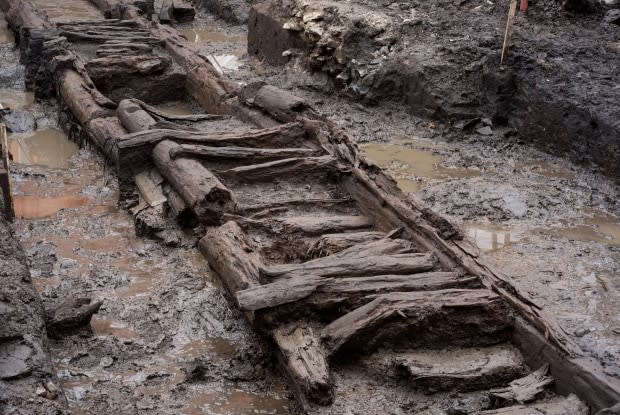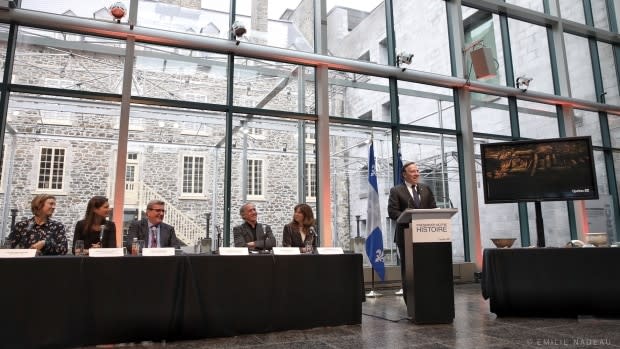Questions arise over dating of Quebec City archaeological discovery
A 2018 archeological discovery — described as the remnants of the first fortifications built to protect New France from a major attack — is being challenged by some Université Laval experts.
However, the archeological firm that unveiled its find to the public to much fanfare is standing its ground about that discovery.
Excavation work at a site on Sainte-Ursule Street in Old Quebec uncovered a wooden stockade in the fall of 2018.
The stockade's location coincided with historical evidence found on a map, dating back to 1700, which shows the Beaucours palisade was built in the same spot.
At a November 2018 news conference to present the findings, they were described as "a major discovery" by Premier François Legault.
But an analysis of two pieces of wood from the structure done recently at Université Laval has called into question the theory that they're part of the first fortifications, suggesting the structure may not date all the way back to 1693.
Geography Prof. Martin Simard did a dendrochronological analysis — which dates the wood based on its tree rings — and found "beyond a reasonable doubt" that one sample dated back to 1751 and the other to 1775.
"Frankly, our results surprised us. We weren't expecting that at all," Simard said.
"Considering the strength of the message that the wall dated back to 1693, we were extra careful. We checked and double-checked to be sure."
Firm defends original theory
Simard's report was included as part of a 326-page document the archeology firm Ruralys submitted to the Quebec Ministry of Culture in early January.
The executive director of Ruralys, Dominique Lalande, said she was surprised to see this small section of the report spark such debate over the weekend, after it was reported by Radio-Canada.
"Specific analysis isn't always consistent with other archeological data," she said.
Lalande said the full report included historical maps and ground analysis, as well radiocarbon dating to determine the age of the trees that were chopped down to make the wooden beams.

The carbon tests, carried out in a laboratory in Miami, Fla., indicated the trees were cut down during the 17th century, in tune with the conclusion reached by Ruralys.
Asked about the discrepancy between the carbon-dating report and his findings, Simard said the dendrochronological analysis is far more precise and was, in fact, used by scientists in the development of carbon-14 dating to calibrate the carbon-dating method and check its accuracy.
Lalande said the science of archeology takes into account a combination of findings and data before going with one theory.
In this case, she said, there isn't any doubt in her mind the structure was indeed the Beaucours palisade.
Wall thought to have protected New France
Josué Dubois Berthelot de Beaucours, a French military engineer, drew the plans for the wooden fortifications built in 1693-94, designed to protect the colony from heavy artillery and cannon balls.
William Moss, who worked for Quebec City as chief archeologist for more than 30 years, pointed out that wall was replaced by stone fortifications in 1745.
Not directly involved in the research, he was nonetheless glad to see a "very enthusiastic, positive response" from politicians in 2018, when the announcement was made.
But holding a news conference, attended by the premier, the mayor and other officials before the final report was ready, was "hasty," he said.
"You have to do your analysis before you start putting information like that out."

Lalande said the timing of the announcement was decided by the Ministry of Culture.
The final report submitted to the ministry has been "reviewed and approved," said ministry spokesperson Émilie Mercier.
"Everything leads us to believe it is indeed the Beaucours palisade," Mercier told CBC News.
The wooden structure is currently in the hands of the ministry's conservation centre in Quebec City, where the wood is undergoing a controlled drying process.
Mercier said no decision has been made about what will be done with it.
In 2018, Mayor Régis Labeaume called the discovery "huge" because it "reinforces our status as a UNESCO World Heritage Site," but he had little to say Monday about the contradictory evidence.
"Honestly, I have enough things on my plate," said Labeaume. "I won't get involved."


